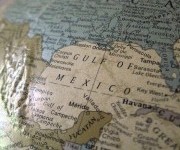Photo: elycefelizCross-posted from Cool Green Science.
Like sequels to a bad zombie movie, the dead zone in the Gulf of Mexico keeps coming back every summer. This time — according to a new NOAA report — it covers 6,765 square miles, exceeding the size of Connecticut.
But what is the “dead zone,” exactly? Why should we care? What can we do about it, and are proposed budget cuts in federally funded conservation programs going to make doing something about it even harder? (You can probably guess the answer to that last question.)
What it is: When excessive nutrients in the Mississippi River reach the Gulf, they cause an algae bloom that then dies and decomposes. Microbes eat the decomposing algae, depleting oxygen to fatal levels for fish and crustaceans, who then have to high-tail it further out into the Gulf where they can breathe easier (or, if that fails, asphyxiate). Scientists refer to this condition as “hypoxia,” but the term “dead zone” accurately and intuitively describes the situation, which usually is at its biggest and baddest in the summer. Similar dead zones occur in dozens of places around the world, but the Gulf of Mexico holds the unfortunate title of world’s largest dead zone.
Why you should care: The Gulf’s dead zone is bad for both people and nature. Fish and other seafood species are threatened by these stressful conditions and the loss of habitat. Fishers have to travel farther out into the Gulf to fish, with significant costs in time and fuel. The dead zone, on average, costs U.S. seafood and tourism industries $82 million each year.
What can we do about it? So, if this is such a big problem, why haven’t we solved it already? Because the majority of the nutrients that enter the Gulf come from agriculture. No one is suggesting that we stop producing food in the Mississippi River basin — that would just mean more land is cleared elsewhere for crop production. So the big question is: How we can produce food without leaking so many nutrients into the water? There is no silver bullet. But there are a lot of silver BBs — actions that, taken together, could put the dead-zone zombie permanently to rest.
Solution: fish-friendly farming
Increased use of the latest, best farming practices will increase the percentage of the fertilizer that is taken up by crops — decreasing the amount that ends up in our rivers and oceans:
- Farmers are increasingly using more precision agriculture (guided by GPS) to apply the right amount of fertilizer at precisely the right place. It’s one reason U.S. agricultural yields keep going up, even though fertilizer application per acre isn’t increasing. For example, corn yields per acre have increased by over 33 percent since 1990, with no increase in nitrogen fertilizer application.
- The timing of fertilizers also matters. Apply it in spring instead of the fall, and snowmelt and early spring rains will be less likely to wash nutrients off farm fields and into rivers. It’s true that spring is a busier time in the field for farmers and that field conditions are generally better in the fall. However, new planting systems allow farmers to apply fertilizers and seeds in one pass or to apply fertilizer after the seedlings emerge. And these techniques work: Such spring applications have been shown to reduce fertilizer loss by 30 percent in some river systems.
- Technological advances within the fertilizers themselves could also help. Fertilizers that include “nitrification inhibitors” cause nitrogen to stick around in soil in the form of ammonium (NH4+) rather than be leached from the soil in the highly mobile form of nitrate (NO3-). (Unfortunately, these fertilizers cost more and so aren’t commonly used.) Plant breeders are also developing crops that are more efficient at taking up nutrients and converting them to high yields without high levels of fertilizer.
- Technologies such as biofilters — buried wood chips that remove nutrients from water before it leaves the farm field — can modify farm fields with tile drainage. And “controlled drainage” structures keep more water on the field during times of year when it is needed, allowing more time for nutrients to be removed.
- Finally, farming practices that reduce runoff — like conservation tillage, cover crops, and terraces — keep both nutrients and soil where they belong: on farmers’ fields. The Natural Resources Conservation Service helps farmers pay for all these techniques.
Solution: putting wetlands to work
But fertilizer management can only do so much to reduce nutrient leaching. Heavy rainfall, combined with increased use of agricultural tile drainage, also plays a role in delivering more nutrients to our lakes and streams. So, if we want to make a dent in the dead zone, we’ll have to adopt technologies that capture and trap nutrients after they leave farm fields.
This is where floodplains and wetlands can help — acting as natural filters, taking up nutrients, and purifying our waters. The waterlogged soils of wetlands slow down runoff with nutrients, and the microbes in these soils filter the water — taking out the nitrogen and turning it into a gas.
But we need to give these wetlands room to work. Throughout the Mississippi River basin, tens of millions of acres of natural wetlands and floodplains have been replaced with cropland and an extensive network of levees, shutting the river off from these natural benefits. In some places, where cropland is repeatedly flooded, nature may be trying to tell us something. The costs are high for levee maintenance and repair, coupled with the costs of subsidies for crops and crop insurance.
Floodplain restoration and reconnection could also contribute to the health and well-being of people. When reconnected and restored, floodplains can help remove nutrients from floodwaters — becoming a source of clean water and potentially benefiting the dozens of cities and towns that get to use the Mississippi as a source for their drinking water. Reconnected floodplains can also store and reduce floodwaters, reducing flood damages — such as those that cost billions this year, not to mention the $30 billion of damages in 1993 and the $15 billion of damages in 2008.
Why proposed federal cuts could make the dead zone even bigger
More and more people are realizing the need for a change in policies around floodplain management, and the important role that farmers can play in providing societal benefits such as clean water. New policies that encourage floodplain reconnection and restoration make a lot of sense — whether you come at the issue from concern about the dead zone’s impact on people’s livelihoods, or the number of people affected by flooding, or impacts to drinking water quality, or rising spending on flood damages and levee maintenance and repair, or the need for habitat along the central flyway used by most of North America’s migratory birds, or just the gut feeling that causing a dead zone larger than Connecticut is wrong.
Existing programs have the potential to help put wetlands back to work. But funding cuts now threaten these programs — including the Farmable Wetlands Program and other Farm Bill conservation programs, the North American Wetlands Conservation Fund, and the Watershed and Flood Prevention program.
One important piece of good news is the Mississippi River Basin Healthy Watersheds Initiative [PDF], part of the USDA’s Natural Resources Conservation Service. This $320 million, four-year program pays farmers in over 40 targeted watersheds — watersheds that are among the biggest contributors of nutrients to the Gulf — to implement practices that avoid, control and trap nutrient runoff, restore and enhance wildlife habitat, and maintain agricultural productivity.
The key word here is “targeted.” Because the majority of the nutrients come from a minority of streams, targeting our conservation dollars provides the biggest conservation benefit for the smallest cost. More smart investments like this are needed to solve our dead-zone problem.
Without increased investments such as this in both “fish-friendly farming” and “putting wetlands to work,” we can expect the dead-zone zombie to come back to a Gulf near you every summer for the foreseeable future.



